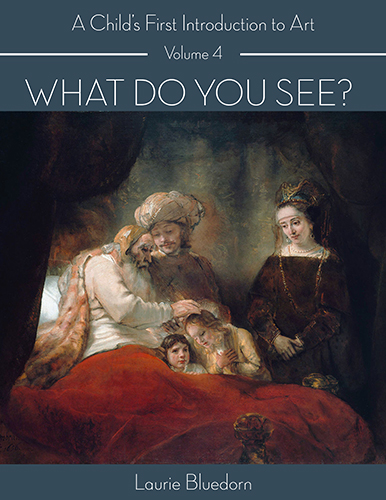What Do You See? A Child’s First Introduction to Art, Volume 4 (E-Book)
$3.49
How to Use This Art Curriculum
This curriculum is a gentle and easy introduction to art appreciation for children, ages 4-12. We teach children to look at a piece of art and evaluate it. We hope to spark in the child a love for the great works of art.
Students will learn:
1. How to identify questions to ask.
2. How to identify why the artist painted what he did.
3. How to identify details the artist placed inside his painting.
4. How they might try to paint something themselves.
5. How to pay attention to the artist and the history of the painting.
The students and teacher should spend time observing the painting and then answer the questions. We recommend that you ask the child to answer the questions orally, not with pencil and paper. We want to make the learning experience enjoyable for you and the children.
This second volume will introduce only one elementary art principle — primary colors.
Some believe that the use of color is the most powerful part of a painting. With colors the artist can communicate to his audience a mood, attract attention, or make a statement. The artist can use color to make his audience feel happy or sad, angry or peaceful. All artists must learn to use color effectively.
Of course, you know that there are many, many colors in the world, but there are three colors which are called primary colors – red, yellow, and blue. These three colors are called primary colors for two reasons: 1. No two colors can be mixed to create a primary color – primary colors can only be created through the use of natural pigments; 2. All other colors can be created by mixing primary colors together.
In this volume of What Do You See? we will be studying only one aspect of color – finding the three primary colors in a painting.
Table of Contents
1. Le Tour Du Monde by André-Henri Dargelas
2. Teaching a Dog New Tricks by John Arthur Lomax
3. The Baptism of the Eunuch by Rembrandt
4. Arabs Crossing the Desert by Jean-Leon Gerome
5. The Blind Girl by John Everett Millais
6. The Good Turn by George Hillyard Swinstead
7. The Animals Entering the Ark by Jan Brueghel the Elder
8. The First Lesson by Louis-Emile Adan
9. Baseball Players Practicing by Thomas Cowperthwait Eakins
10. The Reading Lesson by Paul Seignac
How to Use This Art Curriculum
This curriculum is a gentle and easy introduction to art appreciation for children, ages 4-12. We teach children to look at a piece of art and evaluate it. We hope to spark in the child a love for the great works of art.
Students will learn:
1. How to identify questions to ask.
2. How to identify why the artist painted what he did.
3. How to identify details the artist placed inside his painting.
4. How they might try to paint something themselves.
5. How to pay attention to the artist and the history of the painting.
The students and teacher should spend time observing the painting and then answer the questions. We recommend that you ask the child to answer the questions orally, not with pencil and paper. We want to make the learning experience enjoyable for you and the children.
This second volume will introduce only one elementary art principle — primary colors.
Some believe that the use of color is the most powerful part of a painting. With colors the artist can communicate to his audience a mood, attract attention, or make a statement. The artist can use color to make his audience feel happy or sad, angry or peaceful. All artists must learn to use color effectively.
Of course, you know that there are many, many colors in the world, but there are three colors which are called primary colors – red, yellow, and blue. These three colors are called primary colors for two reasons: 1. No two colors can be mixed to create a primary color – primary colors can only be created through the use of natural pigments; 2. All other colors can be created by mixing primary colors together.
In this volume of What Do You See? we will be studying only one aspect of color – finding the three primary colors in a painting.
Table of Contents
1. Le Tour Du Monde by André-Henri Dargelas
2. Teaching a Dog New Tricks by John Arthur Lomax
3. The Baptism of the Eunuch by Rembrandt
4. Arabs Crossing the Desert by Jean-Leon Gerome
5. The Blind Girl by John Everett Millais
6. The Good Turn by George Hillyard Swinstead
7. The Animals Entering the Ark by Jan Brueghel the Elder
8. The First Lesson by Louis-Emile Adan
9. Baseball Players Practicing by Thomas Cowperthwait Eakins
10. The Reading Lesson by Paul Seignac






Reviews
There are no reviews yet.